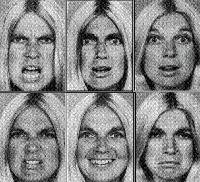Emotional Processing
How Ya Feelin'?! (HDEV 3101 Week 4, 2011)

The above are the SIX classic and universal expressions associated with the basic, or primary, human emotions. Many thanks for Paul Ekman and his socio-emotional-behavioral research team. Assuming you are human and have vision, you should recognize each of these "affects", or expressions of emotions - and you should also be able to name them. Depending on your culture, language or experience, you may used different words to label them, or may express them under different conditions, but they are indeed expressed and perceived consistently across cultures.
"Feeling" or "feelings" is another problematic term for me - it is probably more accurate to use sensation(s), perception(s), or emotion(s). "Feeling" is usually assumed to mean emotional state - "how or what are you feeling?" is an attempt to tap into someones emotional condition, not their sensory-perceptual experience. My point is picky I suppose, but just clarify what exactly it is that you are "feeling" - it's a verb - so, "I am feeling angry" suits me fine; so does, "I am feeling something poke me". Emotional processing is just another example of information processing; on the other hand, some have argued that ALL information processing IS emotional. Or put another way, you are always feeling SOME emotion, and that pattern of activation flavors your cognitive processing. Perceptions, memories, decision making are ALL effected by emotion (and vice versa), so the two are nearly impossible to separate.
Most theories of emotion include some common themes: emotion involves complex layers of processes that are in constant interaction with the environment. Emotional processing involves BOTH cognitive AND physical process.
Basic Phases/Timing of Emotion/Emotional Processing
Initial Orientation/Awareness - we orient toward a stimulus, early activation, focusing of attention, first 100 ms.
Appraisal - what did that stimulus mean? Additional perceptual info on the stimulus tells us more. 100-300 ms.
Arousal, mental and physical (coupled with cognitive appraisal, this gives us experienced emotion, or "feeling"). This represents our full awareness of both the perceptual process and emotional process, now packaged into what we might refer to as a "feeling", or better yet, an "emotion". 350+ ms.
Organizing Emotions
Differential and Categorical - most simple category is the emotional valence. (positive vs. negative emotions).
Primary Emotions - more highly categorized, and yet, basic emotions such as: sadness, fear, joy, anger, disgust or surprise.
Development of emotional maturity is largely about regulating emotional responsiveness. But also may involve more full awareness and acceptance of more complicated emotions as well as recognizing and respecting the emotional states of others. (Recall the types of "change".)
Mood states?
The Profile of Mood States
Mood disorders?
These are actual diagnoses, not just "feelings".

